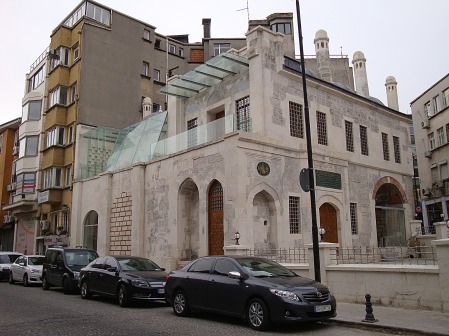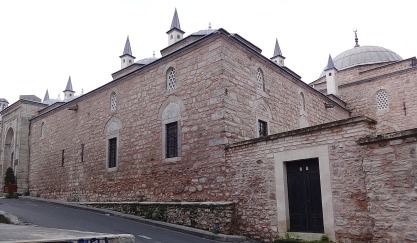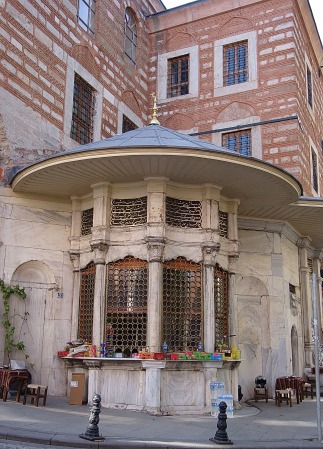Within easy walking distance of Sultanahmet, the Cağaloğlu district is known for a particularly lovely Turkish bath frequented in the past by the likes of Florence Nightingale. This is also where you’ll need to come if you want to apply for a visa from the Iranian Consulate. Some people also pass through Cagaloğlu on their way from Sultanahmet to Kapalı Çarşı (the Grand Bazaar).
Around Cağaloğlu
Walking from Sultanahmet to Cağaloğlu you will pass along Yerebatan Caddesi, beneath which sits the famous Yerebatan Sarnıcı (Basilica Cistern). Crossing over Alay Köşkü Caddesi, which runs downhill to Gülhane and the tramline, will bring you to Cağaloğlu.
Cağaloğlu Hamam (Tel: 0212-522 2424) is on the right-hand side of the road. Built quite late in the day in 1741 when Sultan Mahmud I needed to raise money to add a library to Ayasofya, it was originally called the Yeni (New) Hamamı and was designed with separate sections for men and women – the entrance for women is tucked discreetly to the side. The designs were probably drawn up by the chief architect, Süleyman Ağa, and then brought to fruition by the architect, Abdullah Ağa. Until the opening of the magnificent Hürrem Sultan Hamam in Ayasofya Meydanı many people would have rated this the most beautiful of all the city’s hamams.
If you continue past the hamam you will come to the “restored” Hadım Hasan Paşa Medresesi, built by the architect Davut Ağa between 1595 and 1597 for a vizier to Sultan Mehmed III. The restoration has robbed it of almost all sense of antiquity.

Facing it across the road is a building that was originally designed to house the TC Ziraat Bankası. In front of it sits a bust of its founder, Midhad Paşa (1822-83), a reforming grand vizier of late Ottoman times who found himself accused of murdering Sultan Abdülaziz. Despite his acquittal, he was later murdered while in prison in Saudi Arabia. The building adjoining it was built in 1865 as the Rauf Paşa Konağı and serves as government offices.
Yerebatan Caddesi eventually crosses Ankara Caddesi. If you turn left here you will be able to walk up to pedestrianised Nuruosmaniye Caddesi and thence to Kapalı Çarşı. If instead you turn left and start to walk downhill you will pass on the left the mansion that houses the Iranian Consulate, the first such diplomatic enclave to be permitted inside the old city. It was designed in 1866 by the Italian, Domenico Stampa.
A little further downhill on the right is the İstanbul Valilik (Governor’s Mansion) originally built to house the offices of the grand viziers but adapted to accommodate the Vali after government business was moved to Ankara when Atatürk made it the capital in 1923. Right next door is the delicate little Nallı Mescid, also known as the Vilayet or Babıali Cami, that dates back to 1868. It was completely restored in 2013.
If instead of walking downhill you cross straight over Ankara Caddesi and keep walking straight ahead along Türkocağı Caddesi you will come on the right to the massive building that houses what is still called the İstanbul Boys High School but has actually been co-ed since 1964. It was designed in 1897 by the Levantine architect, Alexandre Vallaury, who was also responsible for the Pera Palace Hotel over in Beyoğlu. Originally it was intended to house the Düyun-u Umumiye, the Public Debt Administrative department created in 1882 when the Ottoman Empire became effectively bankrupt. It was Atatürk’s hope that, in turning the building into a school, he could ensure that a new generation would learn the lessons of its history.

Beyond the school the road bears right and wanders downhill past, on the left, the Rüstempaşa Medresesi, a work of Sinan dating back to 1550 which harks back to the Selçuk style of architecture in which the only external decoration on a building was centred on the entrance. Despite two separate restorations in recent years the medrese is rarely open which makes it hard to appreciate the way in which the octagonal interior has been padded out with rooms around its edges so that externally it appears rectangular.
The building was commissioned by the same Rüstem Paşa who was responsible for the pretty little mosque bearing his name in Tahtakale near the Galata Bridge.
Cağaloğlu to Gülhane

If instead of walking straight along Yerebatan Caddesi you turn right downhill towards the Gülhane tram stop you will pass on the left the Hacı Beşir Ağa Cami dating back to 1745 and with an impressive sebil (water distribution point) reused as a büfe on the corner. The complex included a library (the books are now in the Süleymaniye Kütüphanesi) and a medrese (seminary) that is still in use. An adjacent tekke (dervish lodge) houses the Western Thracian Solidarity Centre.
Transport info
It’s just a short walk from Sultanahmet to Çağaloğlu. The nearest tram stop is Sultanahmet although you can walk uphill along Alay Köşkü Caddesi from the Gülhane tram stop too.
Sirkeci station on the Marmaray line also has an exit for Çağaloğlu. It comes out just in front of the Nallı Mescid.
Nearby areas


